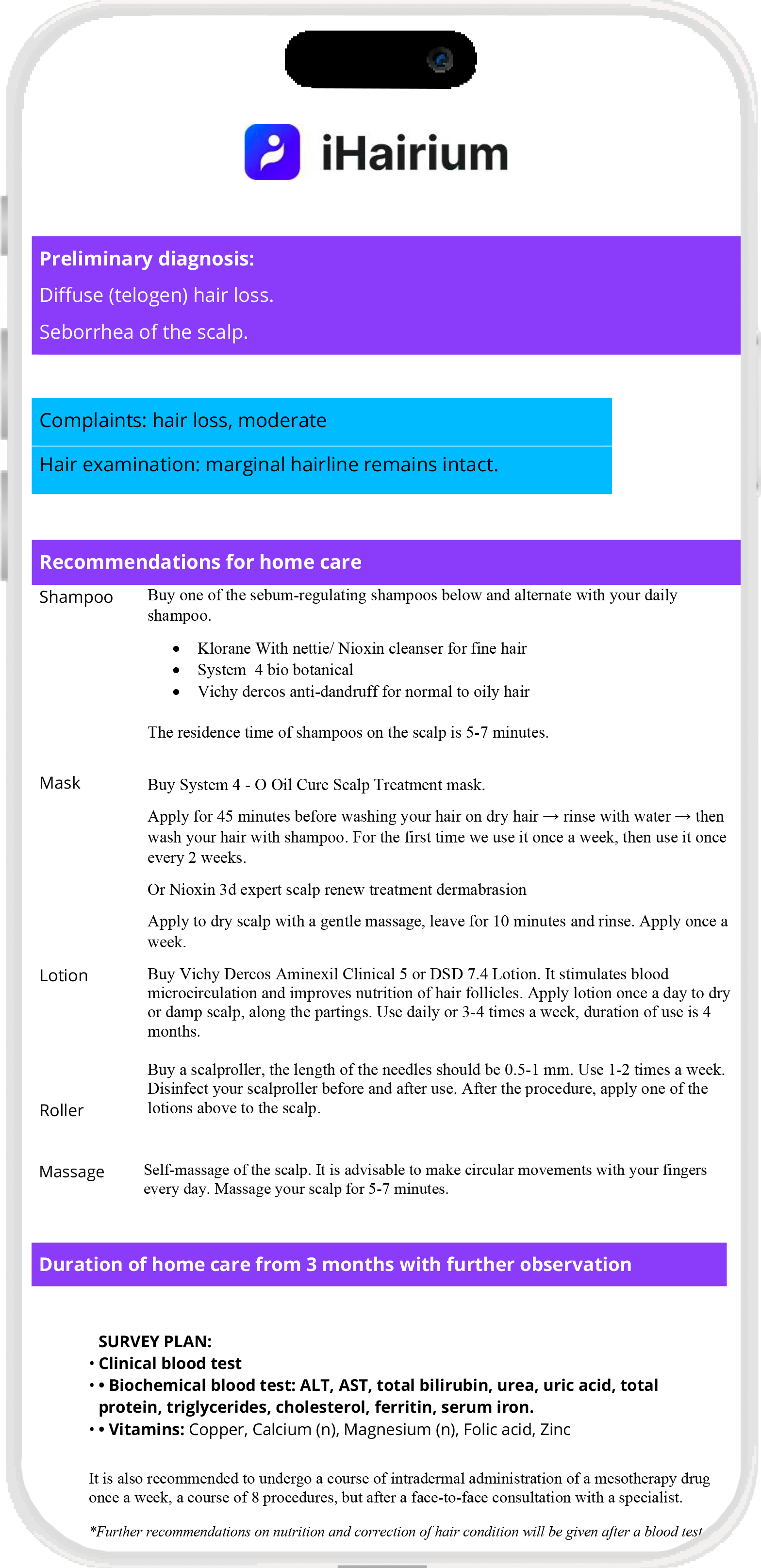
Your results:
Service for the beauty and health of your hair and scalp
or

The causes of these diseases can be:
Ok, what does it mean?
- diseases of viral and bacterial etymology
- stress
- nutritional deficiencies
- wrong diet
The process is reversible and responds well to treatment.
What will happen in the absence of timely access to a doctor and treatment?
It's very important to confirm the diagnosis in time and identity the form of the disease: acute or chronic.
The development of the disease from one form to another takes about 6 months.
The development of the disease from one form to another takes about 6 months.
Multiple recurrences are possible, leading to baldness
Increased risk of developing depression
Increased risk of developing depression
You've got two diseases fit your medical history.
Androgenic alopecia is a common form of hair loss in both men and women. In men, it is also known as male pattern baldness, and in women, it is referred to as female pattern baldness.
In men, hair loss occurs in a distinct pattern, starting with receding hairlines on both sides. Over time, the hairline recedes further, forming the characteristic "M" shape. Hair also thins on the crown of the head (vertex), often leading to partial or complete baldness.
The pattern of hair loss in women differs from that in men. Women experience thinning of hair on the crown, while the central part widens. The hairline typically does not recede. Androgenic alopecia in women rarely leads to complete baldness.
Androgenic alopecia in men is associated with several other conditions, including ischemic heart disease and prostate enlargement.
Furthermore, prostate cancer, insulin resistance disorders (such as diabetes and obesity), and high blood pressure (hypertension) are linked to androgenic alopecia.
In women, this form of hair loss is associated with an increased risk of polycystic ovary syndrome (PCOS). PCOS is characterized by hormonal imbalance, which can lead to irregular menstruation, acne, excess hair growth on other parts of the body (hirsutism), and weight gain.
In men, hair loss occurs in a distinct pattern, starting with receding hairlines on both sides. Over time, the hairline recedes further, forming the characteristic "M" shape. Hair also thins on the crown of the head (vertex), often leading to partial or complete baldness.
The pattern of hair loss in women differs from that in men. Women experience thinning of hair on the crown, while the central part widens. The hairline typically does not recede. Androgenic alopecia in women rarely leads to complete baldness.
Androgenic alopecia in men is associated with several other conditions, including ischemic heart disease and prostate enlargement.
Furthermore, prostate cancer, insulin resistance disorders (such as diabetes and obesity), and high blood pressure (hypertension) are linked to androgenic alopecia.
In women, this form of hair loss is associated with an increased risk of polycystic ovary syndrome (PCOS). PCOS is characterized by hormonal imbalance, which can lead to irregular menstruation, acne, excess hair growth on other parts of the body (hirsutism), and weight gain.
Androgenetic alopecia
Diffuse telogen effluvium is a temporary hair loss condition. This loss is caused by changes in the hair growth cycle.
Events can lead to hair shedding at a faster rate. Such events may include recent traumatic experiences or shock, increased stress, pregnancy, childbirth, or illness. Extreme diets, weight loss, and certain medications can also trigger this type of hair loss.
Hair loss in diffuse telogen effluvium is typically temporary. Once the trigger is identified and resolved, hair usually begins to grow back.
Events can lead to hair shedding at a faster rate. Such events may include recent traumatic experiences or shock, increased stress, pregnancy, childbirth, or illness. Extreme diets, weight loss, and certain medications can also trigger this type of hair loss.
Hair loss in diffuse telogen effluvium is typically temporary. Once the trigger is identified and resolved, hair usually begins to grow back.
Diffuse telogen effluvium
What do you need to do next?
You need to contact a doctor and obtain an individual plan. Choose one of our specialists:
Semih Alev
Dermatologist-trichologist
Сontinue your journey with iHairium right now, without leaving your home!

After consultation
You'll get:
You'll get:

Recommendations from the doctor:
- List of products by hair and scalp type
- Methods and instructions for use
- Additional benefits for hair growth: massagers, curlers, video instructions.
- What tests need to be taken
- Nutrition correction possible

Free access to an online tracker to track results after consultation.









